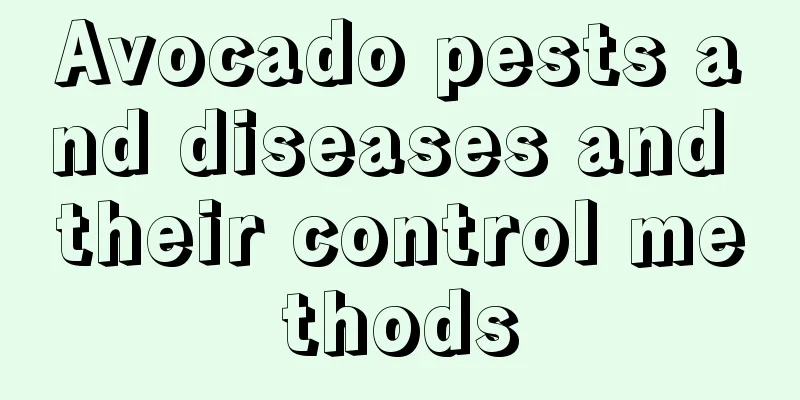Avocado pests and diseases and their control methods

Avocado AnthracnoseThe dangers of anthraxIt will harm mature avocados, and will also attack leaves, twigs, flowers and young fruits, causing fruit drop and fruit rot. The disease usually occurs after the fruit is ripe. The initial lesions are very small, round, slightly concave, and brown or black in color. As the lesions expand, the depressions become more obvious and the lesions appear cracked. Eventually, the lesions develop into large areas with pink conidia appearing on the lesions. The pathogen can also invade the ripe flesh, causing the fruit to dry out and rot, and turn black-green in color. Anthracnose controlThe diseased branches and leaves must be removed to eliminate the source of infection, and the picked fruits must be treated with low temperatures. Avocado scabThe harm of scabThe fruits infected with scab will initially have inconspicuous round brown scar-like protrusions, which will later turn into light purple. When the fruit is ripe, the spots will unite into one piece, the center will become sunken, and the skin will become rough. Scab does not affect the flavor quality of the fruit, but it will affect the appearance of the fruit. Prevention and treatment of scabCut off the diseased branches and spray Bordeaux mixture or other copper preparations to prevent scab. Cercospora spotThe harm of Cercospora spot diseaseThis disease can harm leaves, stems, and fruits, forming dead spots on the surface of the fruit or causing the epidermis to crack, and forming dead spots on the surface of the leaves with irregular shapes. Prevention and control of Cercospora spot diseaseChemical methods can be used for prevention and control, such as spraying copper preparations or myclobutanil on branches and fruits. Avocado pit rotThe harm of small hole fruit rotThis disease is very obvious during the ripening process of the fruit after it is harvested and softened. In the early stage, there will be some small and irregular spots on the skin, the flesh will have brown stripes, and then purple-brown irregular spots will appear on the fruit stalk. As the fruit matures, the area of the lesions will become larger and larger, the peel will be covered with mycelium and spores, and brown flesh and juice will flow out, with a very unpleasant smell. Prevention and control of small hole shell fruit rotPrune off diseased and dead branches, remove dead wood and diseased fruits, and eliminate the source of infection. When picking fruit, choose sunny weather to supplement and strengthen the nutrition of the fruit trees and reduce the occurrence of other diseases. Avocado stem rotHarm of stem rotThe first part to be infected is the fruit stem. As the fruit matures, the bacteria will invade the fruit. A very obvious black rotten area will appear with the stem as the center, and later it will spread to the entire surface of the fruit. After the bacteria invade the flesh, the fruit will emit an unpleasant odor. Stem rot prevention and treatmentClear the source of infection promptly, water the lower parts of the orchard to prevent the pathogen from moving to the fruits higher up, cover the fruit trees with film or weeds to promote the decomposition of diseased residues, and be careful not to harvest the fruit on rainy days. Avocado Phytophthora Fruit RotThe harm of Phytophthora fruit rotIt can cause fruit rot before or after the fruit is picked, and can also cause stem rot. Fruits infected with this disease will develop black circular spots near the stem, and the flesh will also be invaded by the bacteria. Prevention and control of Phytophthora fruit rotPrune off diseased dead branches and stems, clean up fallen and diseased fruits in the orchard, and cover the fruit trees with thick mulch to inhibit the spread of pathogens in the soil. Avocado sooty diseaseThe harm of soot diseaseLarge amounts of black, sooty hyphae and spores will appear on the surface of fruits, leaves, and stems, and will also grow on the honeydew secreted by whiteflies. Prevention and treatment of soot diseaseUse natural enemies for biological control. |
<<: Diseases and Pests of Red Rhododendron and Their Control
>>: Common diseases and pests of Rhododendron tubulosa and their control methods
Recommend
The correct way to change the pot and soil of green radish
Green ivy is a common indoor foliage plant. It is...
Can wine lees be used as fertilizer?
Wine lees as fertilizer Wine lees can be used as ...
What is the best season to plant Italian lettuce?
Best time to plant Italian lettuce Italian lettuc...
Breeding methods and precautions for black rabbit ears
1. Maintenance methods 1. Temperature: It has str...
How long does it take for cherry blossom cuttings to take root? How to propagate cherry blossoms by taking root
Cherry Blossom Cutting Rooting Time The best time...
Can soil mint be hydroponically cultivated? How to cultivate hydroponically mint?
Can mint be grown hydroponically? Mint can be gro...
Gardenia becomes an old tree in 3 months, with strong roots, green leaves and full branches of flowers. I won’t sell it for any amount of money!
How to turn a gardenia potted plant into an old b...
What to do if the leaves of Tiger Pilan turn yellow
1. Reduce light exposure: Reason: If the leaves a...
The difference between Artemisia scoparia and Artemisia chrysanthemum
1. Leaf Difference The leaves of Artemisia argyi ...
One rose tree blooms with five colors of flowers, just because it was cut with one knife! It suddenly turns into a waterfall of flowers!
Camellia grafting, quickly grow old There are sev...
What is watermelon? It is a crop belonging to the Cucurbitaceae family.
What kind of crop is watermelon? Watermelon is a ...
Do cacti like the sun?
Cactus likes the sun Cactus likes sunlight and is...
Now you can just scatter some seeds and you don’t have to buy vegetables for half a year!
Peas 1. Select healthy and plump peas and soak th...
How to propagate Tiger Eye Dieffenbachia
Bulb division propagation of Ornithogalum Tiger e...
How to water the fortune tree correctly
1. Watering frequency You don't need to water...









